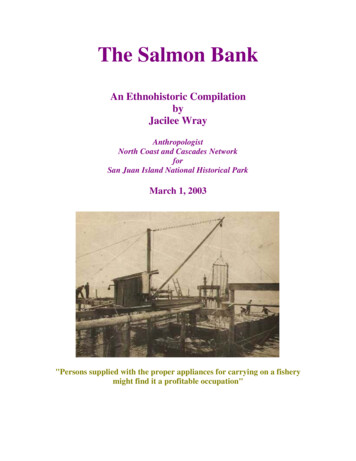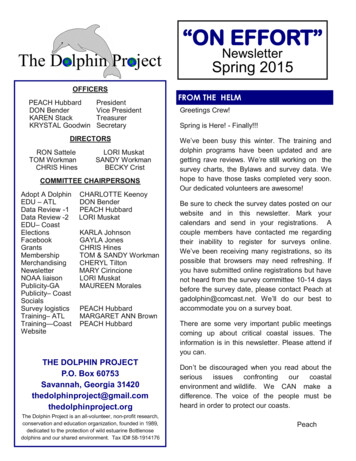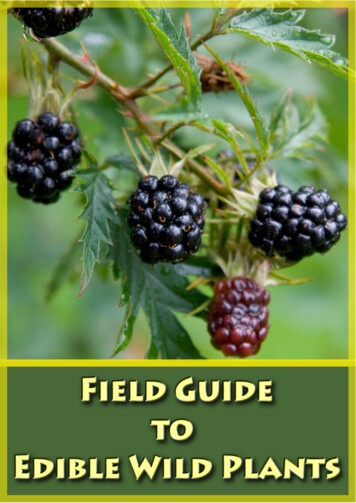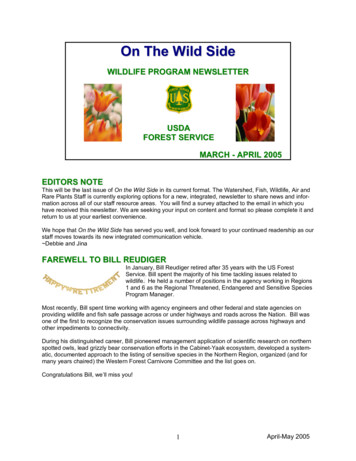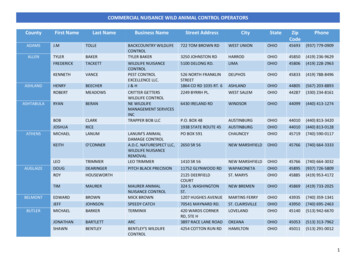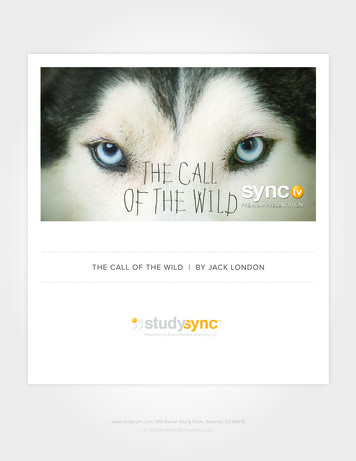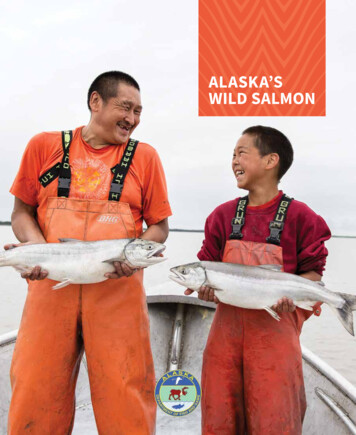
Transcription
ALASKA’SWILD SALMON
HUMPIES JOE SERIO, USFS
ACKNOWLEDGEMENTSPrincipal Writer/Editor: Bob KingProduction Managers: Peter Bangs ADF&G, and Sarah Warnock, Nautilus Impact InvestingDesigner: Debbie Whitecar, Silt & SticksThe Alaska Department of Fish and Game (ADF&G) would like to thank Jonathan Lyman, the ADF&G employeewho was principal author of the 2002 version of this booklet, and the following contributors:ADF&G contributors: Peter Bangs, Forrest Bowers, Rich Brenner, Tammy Davis, Dani Evenson, Jim Fall, Adam Knight,Sabrina Larsen, Marie Megan, Jef Milton, Andrew Munro, Lisa Olson, Mark Stopha, Terry Thompson, and Jennifer WomackOther Contributors: Ian Dutton, Nautilus Impact Investing; Peter Westley, University of Alaska Fairbanks;Courtney Carothers, University of Alaska Fairbanks; Larry Kaplan, University of Alaska Fairbanks, Alaska NativeLanguage Center; members of the working groups of the State of Alaska’s Salmon and People Project(alaskasalmonandpeople.org); National Center for Ecological Analysis and Synthesis (nceas.ucsb.edu); Zoé Styron,Element Agency (elementagency.us); Erin Harrington, The Salmon Project(salmonlife.org); and Helena Jacobs, Salmon ConnectPHOTOS AND ILLUSTRATION CREDITSCover: Corey Arnold, courtesy of Alaska Seafood Marketing InstituteTitle Page: Underwater sockeye salmon, photo Jonny ArmstrongEndpapers: Humpies: photo Joe Serio, USFSBackpage: Danielle and Sockeye: photo Mary Catherine Martin, SalmonStateOther Photos and Illustrations: Alaska Dept. of Fish and Game, unless credited 2019 Alaska Department of Fish and GameThe ADF&G administers all programs and activities free from discrimination based on race, color,national origin, age, sex, religion, marital status, pregnancy, parenthood, or disability. The departmentadministers all programs and activities in compliance with Title VI of the Civil Rights Act of 1964,Section 504 of the Rehabilitation Act of 1973, Title II of the Americans with Disabilities Act of 1990,the Age Discrimination Act of 1975, and Title IX of the Education Amendments of 1972.If you believe you have been discriminated against in any program, activity, or facility, or if you desire further information, please write to ADF&G,P.O. Box 25526, Juneau, AK 99802-5526; U.S. Fish and Wildlife Service, 4040 N. Fairfax Drive,Suite 300 Webb, Arlington, VA 22203; or O.E.O., U.S. Department of the Interior, Washington DC 20240; or call 907- 465 - 6078.
JONNY ARMSTRONGALASKA’SWILD SALMON
Audrey Armstrong, an Athabascan artist, is teaching anew generation the ancient technique of salmon skinsewing. “Salmon skin work is a lot of work, just scraping,scraping, scraping. But when you are done with yourwork and your creation, it’s worth it.”— Sewing (and Sharing) with Salmon, Salmonlife.org BETHANY GOODRICHCONTENTSIntroduction – Salmon in Alaska71The Evolution of SalmonThe Evolutionary StoryAdaptability – A Perilous Gift of Nature8892Salmon BiologyAlaska Pacific Salmon IdentificationPacific Salmon Life CycleThe Gift of DeathThe Pacific Salmon Food Web10111418193Alaska’s Salmon Habitats – A Delicate BalanceWatershedsSalmon Producing Areas in Alaska2020284Conserving our WaterLaws to Protect Clean Water and HabitatPollution and ContaminantsCommunity Steam RestorationInvasive Species29303234345The Harvest of SalmonNative TraditionsThe Connection of CampSubsistence – A Way of LifePersonal Use FishingCommercial Salmon FishingHomeward StorySportfishing36374041424243466Management and ResearchSalmon ScienceSalmon in a Changing ClimateHatchery Management505152537Partners for SalmonPublic InvolvementInternational PartnersState AgenciesSalmon Related Programs5757585860APPENDIXReferencesGlossary626263
6 BREANNA PETERSON
The survival of Pacific salmon depends upon our abilityto protect, maintain, and improve salmon ecosystems inharmony with current human development. KBNERRIntroductionIt is up to each of us to learn how to protect Alaska’ssalmon and their habitats.SALMON IN ALASKAAlaska is one of the world’s last great strongholds forhealthy stocks of wild Pacific salmon and intact salmonproducing ecosystems. In contrast to salmon throughoutthe rest of their range, no populations of salmon in Alaskaare listed as threatened or endangered. Our watershedscreate ideal conditions for wild salmon. The land is lacedwith a rich mosaic of freshwater habitats that feed riversleading to saltwater bays and the oceanic expanse of theNorth Pacific.Salmon are magnificent fish with an unusual andcomplex life cycle. They are essential to our people, ourwildlife, and even the health of our land and forests.Salmon are interwoven into our ecosystems, oureconomy, and our cultures. Whether drying on the racksof a fish camp on the Yukon River or tugging on the endof an angler’s line, salmon are part of daily life in Alaska.You’ll see them on paintings, sculpture, jewelry, and evenT-shirts. Heralded in songs and dances, Native totemsand icons, festivals and celebrations, wild salmon rundeep within the lifeblood of Alaskans.This strong connection of people to salmon inAlaska is unique, having been lost by declines in salmonabundance and distribution throughout Europe, the EastCoast of North America, and the Pacific Northwest. Asurvey by The Salmon Project found three out of everyfour Alaskans report being strongly connected to salmonand that wild salmon were very important to thempersonally and to Alaska.Salmon are a major part of Alaska’s economy. Salmonprovide jobs for commercial fishermen, processingline workers, hatcheries, and the many trades thatmaintain our fishing boats and fish processing plants,and support our coastal communities. Sport fishing isanother significant economic driver in Alaska. Hundredsof thousands of resident and nonresident anglers enjoyour rich marine and freshwater salmon fisheries, fillinghotels and restaurants, patronizing local tackle shops,and hiring guide services throughout the state.Although Alaska salmon populations arerelatively healthy, challenges remain due to changes inhabitat, such as rising water temperatures and oceanacidification. There is still much to be understood aboutinteractions between wild salmon and those reared inthe state’s hatcheries.Fishermen are challenged by the cyclical nature ofsalmon runs, changing seafood markets, and changingclimate. Alaskans often disagree about the best way toprotect salmon, and who gets to catch them, but togetherwe are responsible for sustaining salmon populationsin Alaska. They are a biological, economic and culturalresource that nourishes us as a people and have done sosince the first Alaskans arrived millennia ago.Alaskans cherish wild salmon. This is the story ofAlaska salmon and the important role played by theAlaska Department of Fish and Game in protecting,managing, and sustaining this vital resource.Unlike many states in the union, Alaska enshrined itsregard for natural resources in its constitution. Becausefish and wildlife were recognized as critically importantto the fledgling state, the Alaska Department of Fish andGame was created as a cabinet-level department run by acommissioner, who answers directly to the governor. Thedirectives of the constitution were included in statuteby the legislature under Alaska Statute 16.05.020. Thefunctions of the commissioner are to manage, protect,maintain, and improve the fish, game, and aquatic plantresources of the state in the interest of the economy andgeneral wellbeing of the people of the state.Part of a “solid sport fishing family”, Aubrey Dela Cruz also works as a fish processor on Kodiak’s waterfront,while husband Randy works to fuel up seiners. — A Salmon Family, in Sickness and in Health, Salmonlife.org7
1 RAY TROLLArtist’s rendition of a spiketoothed salmon. Weighinghundreds of pounds, thissalmon lived during theMiocene age and is oneof many that existed longbefore today’s Pacificsalmon evolved.THE EVOLUTION OF SALMONThe Evolutionary StoryPacific salmon evolved from a shared European ancestor between 50 and 100 million years ago.Based on several lines of evidence, many scientistsbelieve today’s diverse species of salmon in Alaskaevolved from a shared ancestor with Coregoninae,or whitefish, in northern Europe between 50 and100 million years ago. Over the next 30 millionyears, grayling, whitefishes, and some lesser-knownsalmonid species such as lenok and taimen split fromthis common ancestor and followed their uniqueevolutionary paths.Another branch evolved into the group thatincludes Pacific and Atlantic salmon. These two groupsdiverged from a common ancestor approximately15 to 20 million years ago. While Atlantic salmonremained a single, although highly variable, species,Pacific salmon radiated into the multiple species weknow today as members of the genus Oncorhynchus.This evolution occurred during an epoch of repeated8glaciation, known as the Pleistocene, which endedaround 10,000 years before present.Salmon that found home in rivers soon evolvedinto Chinook and coho salmon. Others that flourishedby rearing in lakes for one or two years and returnedto fresh water in their fourth or fifth year evolvedinto sockeye salmon. About eight million years ago,their relatives that spawned closer to the marineenvironment evolved into pink and chum salmon.Alaska’s trout, also part of the genus Oncorhynchus,broke off and five million years later divided into whatwe know today as rainbows and cutthroat. Anothervariant emerged in Asia, known as Oncorhynchusmasou, or cherry salmon, with the freshwater varietyof this species referred to as amago salmon. Cherrysalmon are not found in Alaska.Although the big evolutionary transitions in the
PHOTO COURTESY OF THE BURKEMUSEUM OF NATURAL HISTORY ANDCULTURE. CATALOG NO. UWBM VP87118.Pacific salmon life history occurred by about five millionyears ago, much of the diversity we observe, and strive toprotect, in Pacific salmon is much younger. Alaska’s activeglacial history opened new spawning and rearing areasthat provide new opportunities for salmon. Although thevast majority of Pacific salmon return home to spawn,some individuals stray from home and can colonize newhabitats and form new populations. Because conditions,such as flow and temperature, differ among differentstreams, salmon become adapted to local conditions.These adaptations are comparable to a ‘home fieldadvantage’, where local fish outperform non-local fish intheir home streams.Alaska salmon come from a wide evolutionaryhistory that is still evolving. While salmon have a longhistory of evolving and adapting to changes in theirenvironment, it has only been during the last 150 yearsthat industrialized society has altered Pacific salmonhabitats. Today, the survival of Pacific salmon dependsupon our ability to manage harvests and protect,maintain, and improve salmon ecosystems in harmonywith human development. It remains unclear whethersalmon will be able to adapt quickly enough to survive ina rapidly changing world.Adaptability – A Perilous Gift of NatureScientists have two major concerns for salmontoday: preserving genetic diversity so each species canadapt to changing climatic conditions, and preservingnatural habitats so that local populations of wild salmoncan thrive. The ability of salmon to gradually adapt tochanges in their environment helped them evolve tospend a portion of their lives in fresh and saltwater.This adaptability carries a hidden price. Wild salmonneed pristine fresh water for spawning and rearing, andaccess to clean oceans, rich with a broad variety of food.Throughout their complex life cycle, salmon must havesufficient amounts of unpolluted water and undisturbedhabitat to survive.Sockeye SalmonPink SalmonSalmon fossil from the Pleistocene EpochChum SalmonChinook SalmonCoho SalmonMasu SalmonRainbow Trout/SteelheadCutthroat TroutAtlantic Salmon2015105MILLION YEARSBEFORE PRESENT9
2SALMON BIOLOGY10Alaska is home to seven species of Pacific salmon:Chinook salmon, sockeye salmon, chum salmon, pinksalmon, and coho salmon, as well as rainbow trout andcutthroat trout. Names for these species are as diverseas the fish themselves. Chinook salmon are also knownas ‘king’, ‘spring’, ‘Tyee’, or ‘blackmouth’ salmon. Somecall sockeye salmon a ‘red’ or ‘blueback’, chums a ‘dog’or ‘keta’, pinks ‘humpback’ or ‘humpy’, and coho a‘silver’.Having multiple names can cause confusion. TheKoyukon people of the middle Yukon River refer to fallchum salmon as ‘silvers’ because they are still silverybright from the sea. Not to be confused with cohosalmon, the name also contrasts with spring chumsalmon that are more colored and once used to feedvillage sled dog teams, hence are called ‘dog’ salmon.Most salmon are anadromous, meaning they areborn in fresh water, migrate to saltwater to feed andgrow, then return to spawn in the rivers and lakes wherethey were born. They undergo dramatic changes incolor and appearance to attract mates in this last phaseof their life. Chinook, sockeye, coho, pink, and chumsalmon all die after spawning, a life history strategycalled semelparity. This life history is exceptionally rareamong the approximately 32,000 other species of bonyfishes, making these species that much more special.Pacific salmon are members of the genusOncorhynchus, Latin for “hooked nose.” The name refersto the enlarged nose and teeth that grow when salmonreturn to fresh water. These changes allow salmon tofight members of their same species on the spawninggrounds. The Latin name is often shortened to just theletter “O.”, followed by their common name in Russian,where western naturalists first described the differentspecies: O. tshawystcha (Chinook), O. nerka (sockeye),O. keta (chum), O. gorbuscha (pink), and O. kisutch(coho).Two species of trout in Alaska also belong to thesame genus as Pacific salmon. Rainbow trout andcutthroat trout are classified as O. mykiss and O. clarkii.Unlike other members of the genus, rainbow trout andcutthroat trout can spawn multiple times, a life historycharacteristic called iteroparity. The term ‘salmon’ inAlaska implicitly refers to the members of Oncorhynchusthat die after spawning.Another species of Oncorhynchus is found only inAsia: O. masou, known as Masu or cherry salmon. Thereis some debate whether multiple species of Asian salmonexist. Current evidence suggests four subspecies ofO. masou, based on geographical distributions and lifehistories. Cherry salmon are frequently anadromous,and usually die after they spawn yet some males andstream-rearing females have been observed to spawnmultiple times during their lives. JASON S CHINGSalmon are anadromous, which means they spawn in fresh water, migrate to the oceanwhere they feed and grow rapidly, and then return to fresh water to spawn and die.
ALASKA PACIFIC SALMON IDENTIFICATIONCHINOOK SALMON: also known as king, Tyee, spring, or blackmouth“The chowichee of the Yukon is the king of salmon,” wrote explorer William Dall in 1865. During the years ofRussian America, barrels of oil-rich Chinook salmon were shipped to the Tsar and considered a rare delicacy.The Chinook salmon (O. tshawystcha) is Alaska’s state fishand one of the most important sport and commercial speciesnative to North America’s Pacific coastal ecosystems. Theyare found from the Southeast panhandle to the Yukon River,and increasingly encountered as far north as Utviagvik,formerly known as Barrow. Chinook salmon are distinguishedfrom other species by black spots on the back, dorsal fin,and both the upper and lower lobes of the tail or caudal fin.Chinook salmon also have a dark pigment along the gum line,and gave them the nickname “blackmouth” in some parts oftheir range.Chinook are the biggest salmon in Alaska but do vary insize. Many anglers encounter fish between 20 and 40 pounds,but often catch Chinook that are much larger. The recordsport-caught Chinook salmon was taken in the Kenai Riverin 1985 and weighed 97 pounds. The largest commerciallycaught Chinook weighed 126 pounds and was taken in 1949in a fish trap near Petersburg.The chances of encountering truly large Chinook salmonare becoming increasingly unlikely, as the average size offish returning to spawn has declined since about 2000. Thesmaller size is primarily because fish are returning at youngerages. Six- and seven-year-old fish that were once importantparts of many stocks are now largely absent and most arematuring as five-year-old or younger fish.Chinook salmon undertake remarkable migrations toreach their spawning streams on some of the larger riversystems. Chinook salmon bound for headwaters in Canada’sYukon travel more than 2,000 miles up the river. Dependingon her size, female Chinook salmon produce approximately5,000 to 14,000 eggs. The eggs can be fertilized by one orseveral males and deposited in gravel nests called redds.SOCKEYE SALMON: also known as red or bluebackSockeye means diferent things to diferent users: money in the bank for commercial harvesters, foodsecurity for a rural subsistence user or urban personal use harvester, and combat fishing for anglerslined up along the Kenai Peninsula’s Russian River every summer.Sockeye salmon (O. nerka) is arguably the most valuablespecies of the Pacific salmon given its value per pound andthe amount of fish harvested. Its strong fighting ability, firm,rich meat, and bright color make it a premium product desiredby consumers, industry, subsistence users, and anglers alike.Sockeye salmon usually weigh between four and eightpounds, and are between 18 and 24 inches long. Breedingmales develop a humped back and elongated, hooked jawswith sharp teeth called a kype. Both males and females turna brilliant red on the back and sides, olive-green on the head,and white along the lower jaw. A female sockeye producesbetween 2,000 and 4,500 eggs.Sockeye salmon spawn in rivers, streams, and in springfed upwellings or wind-circulated currents along the shores oflakes. They are largely dependent on lakes for feeding prior tomigrating to sea. After emerging from the gravel, they typicallystay in the lakes for one or two years before migrating out tothe ocean, although there are some variations. Some sockeyesalmon migrate to sea after only spending part of a summer infresh water while others rear in rivers rather than lakes. Somespend their entire lives landlocked in fresh water. Commonlycalled kokanee, they are found in the upper Copper River andelsewhere in Alaska.The name sockeye comes from ‘suk-kegh,’ which means“red fish” in the language of the indigenous Salish people ofCanada’s Fraser River.11
CHUM SALMON: also known as keta or dogThe chum is the gladiator of the salmon world with undying fight! Chums make excellent smoked fish andtheir eggs are prized as a delicacy.Chum salmon (O. keta) have the widest distribution andarguably the most diverse life history of any of the Pacificsalmon. They are found throughout coastal Alaska wherethey frequently spawn in intertidal areas, where fresh watermeets with salt, and in all major river systems. Chum salmonalso migrate thousands of miles up the Yukon River intoCanada and can spawn late into the fall and early winter ingroundwater upwelling areas of large rivers. Chum salmonare a traditional source of dried fish for winter use and a majorcomponent of commercial fisheries, especially in SoutheastAlaska where chum salmon are produced in hatcheries toenhance commercial fisheries.Chum salmon usually weigh between 7 and 18 poundsand are between 24 and 32 inches long. Ocean bright chumsalmon are greenish-blue with fine black speckles. As theynear fresh water, they turn green with purple stripes. Malechums develop the famous “hooked snout” of Pacific salmonand large, canine-like teeth that help account for the namedog salmon.A female chum salmon produces between 2,400 and3,100 eggs. Juvenile chum salmon migrate to sea in theirfirst summer of life, often immediately after hatching andemerging from the gravel.PINK SALMON: also known as humpbackExtremely valuable in large numbers, the humpy is the most abundant salmon species in Alaska withcommercial catches up to 219 million fish in a single season.The pink salmon (O. gorbuscha) is called a ’humpy’ becauseof the pronounced hump that develops on the back of adultmales before spawning. The smallest Pacific salmon in NorthAmerica, pinks have an average weight of about three-anda-half to four pounds, and length between 15 and 24 inches.An adult humpback returning from sea is bright steelyblue on top and silvery on the sides, with many large ovalblack spots on the back and tail fin.Some pink salmon head up their natal rivers like othersalmon, but many pinks spawn in intertidal areas. Females12produce between 1,500 and 2,000 eggs. Once hatched,pink fry spend very little time rearing in fresh water beforemigrating to the ocean. Frequently their trip to sea startsimmediately upon emerging from the gravel.Pink salmon dominate Alaska hatchery production withthe release of about 900 million fry each year that result inannual returns of adults that average 45 million have peakedas high as 90 million, most from Prince William Sound.ALASKAN PACIFIC SALMON IDENTIFICATION FISH PHOTO ILLUSTRATIONS COURTESY OF THE ALASKA SEAFOOD MARKETING INSTITUTE. FOR ADDITIONALINFORMATION ON THESE FISH AND OTHER ALASKAN SPECIES, VISIT THE WEBSITE: WWW.STATE.AK.US/ADFG
COHO SALMON: also known as silverCohos are a uniquely aggressive salmon. They will rush toward you, dive, jump into the skif, and jumpback out. A very in-your-face, take-charge kind of fish.Coho salmon (O. kisutch) are found in coastal waters of Alaskafrom the Southeast Panhandle to Point Hope on the ChukchiSea, and in the Yukon River to the Canadian border. Cohosalmon occur in nearly all bodies of fresh water that flow tothe Pacific Ocean and Bering Sea.Adult coho salmon usually weigh eight to 12 pounds andcan be between 24 and 30 inches long, with some considerablylarger. Adults in salt water, or recently arrived in fresh water,are bright silver with small black spots on the back and thecaudal, or tail, fin.Coho salmon enter spawning streams from July toNovember, usually during periods of high runoff. Cohosalmon occur throughout stream networks but are known forfavoring the headwaters of streams. Adults struggle their wayinto small tributaries following fall rains before spawning,where the female produces between 2,400 and 4,500 eggs.Juveniles typically spend one to three years rearing infresh water before their seaward migration. Some juvenileAlaska coho salmon enter estuarine waters soon afterhatching and are referred to as “nomads.” This is an exampleof life history diversity that allows the species to be veryresilient to environmental changes in the river. Time spentat sea varies. Some males, called “jacks,” mature and returnafter only six months at sea, while most coho spend 18 monthsin salt water before returning as full-size adults.COASTAL RAINBOW TROUTCOASTAL CUTTHROAT TROUTRainbow trout are the great-grandparents ofsalmon, their originator. To release a steelhead isto cradle the past in your hands and send it to thefuture, a promise you make to the fish, the water,and yourself.“Cutthroat trout are beautiful fish found in beautifulplaces. They have also been described as the canaryin the coal mine: the first species to succumb toenvironmental degradation.” Dr. Robert BehnkeMost coastal rainbow trout (O. mykiss irideus) in Alaska arethe stream-resident form that stay primarily in freshwater,although some will spend periods of time feeding in estuarineor near-shore marine waters. The larger and much rarerform is steelhead, which leave freshwater as juveniles andmigrate long distances in the ocean where they grow tomaturity before returning to their natal stream for spawning.Depending on the area, steelhead can return to freshwater ineither spring, late summer, or fall, but they always spawn inthe spring. Unlike other species of Pacific salmon, rainbowtrout can spawn more than once in their lifetime.Rainbow trout are native to Alaska waters from SoutheastAlaska north to Kuskokwim Bay. The color and shape ofrainbow trout is highly variable and often shaded from bluegreen to olive with a reddish-pink band along each side. Thelower sides are usually silver, turning to pure white beneath.Small black spots dot the upper back, as well as on the upperfins and tail. Rainbow trout vary from a few inches in length togiant steelhead that can top 40 inches and weigh 20 poundsor more.Coastal cutthroat trout (O. clarkii clarkii) are found yearround in streams and lakes throughout Southeast Alaska. Someare resident in streams and lakes, while others spend a portionof their lives in saltwater. Cutthroat trout can spawn multipletimes in their lifetime, but due to the high energetic cost ofspawning, females often do not spawn in successive years.Cutthroat trout typically produce a few hundred eggs or less,with smaller females producing fewer and smaller eggs.The size of cutthroat trout depends on where they live.Sea-run cutthroat trout can reach lengths of 16 to 22 inches.Resident cutthroat trout are typically much smaller (10 inchesor less) and can live 15 years or more. The largest cutthroat arefound in lakes and can grow up to 26 inches long.Resident cutthroat trout are golden yellow with dark spotsand a vivid red slash mark under the jaw, giving the species itsname. Sea-run cutthroat trout typically reside in lakes duringthe winter, migrate to salt water to feed in the early spring, andreturn to lakes in the fall. Sea-run cutthroat trout are bluishsilver with dark or olive backs and less conspicuous spots andslash marks.13
OTHER WILD SALMONIDSArctic charDolly VardenArctic graylingsheefish/whitefishlake trout ALASKA DEPARTMENT OF FISH AND GAMEFertilization takes place externally, as thesperm washes over the eggs in the redds.14Pacific Salmon Life CycleMost Pacific salmon start their lives as freshwater fish,then develop the ability to live and grow in the oceanwhere they mature. They return to intertidal andfreshwater lakes and streams as adult fish to reproduceand die.After returning from the ocean, the female’s eggsbegin to ripen within her. When her eggs are ripe, shelocates a suitable spawning area and hollows out a reddin the gravel with her tail. Each species of salmon looksfor different qualities in the habitat that they choose forredds, although all good salmon nesting habitats havesome similar features: clean and well oxygenated water,consistently cold water that has the right depth andflows at the right speed, and gravel that’s the right sizeand depth.While the female is busy making her redd, malesalmon hover nearby and fight for breeding rights. Thewinning male waits until the female settles into her redd USFS ALASKA REGION, USDAOther Wild Alaskan Salmonids (species related to salmon)
alevins ALASKA DEPARTMENT OF FISH AND GAME ALASKA DEPARTMENT OF FISH AND GAMEeggsAfter one to two years for Chinook, one to fiveyears for coho, and up to four years for sockeye, salmonbecome smolts. Instead of staying in the slow watersclose to the bank or river bottom, smolt swim up into thesurface currents. This helps them migrate downstreamto saltwater estuary areas at the mouth of their homerivers. In estuaries, where fresh and salt water mix,smolts undergo a series of internal and external changesthat will allow them to live in the salty environment ofthe ocean.Salmon go to sea in search of food. There are notenough insects, invertebrates or other fish in fresh waterto feed the great numbers of growing salmon. However,the cold waters of the North Pacific Ocean can be veryproductive, and salmon grow rapidly, feeding on a varietyof prey species. Salmon spend different amounts of timeliving in estuaries or the open ocean, depending on thespecies and stock. After spending from six months tosix years feeding and maturing there, adult salmon are ALASKA DEPARTMENT OF FISH AND GAMEto expel her eggs, and then he moves next to her to fertilizethe freshly laid eggs with his sperm or milt. Sometimesmultiple males are involved. Positioned some distanceaway, satellite or sneaker males dart toward the femalewhile she expels her eggs. The female then covers thefertilized eggs with gravel and begins building anotherredd to deposit more eggs. One male may fertilize severaldifferent redds. One female may build several redds,which may be fertilized by different males each time.The eggs, now safely buried in the streambed, developslowly. In winter or early spring, the developing salmonbreak though the egg’s thin shell. At this stage the youngsalmon, called alevins, still have a yolk sac attached tothe abdomen.The alevins rely upon the yolk sac for food and dependon the surrounding gravel for protection or cover. Whenthe young fish, now called fry, deplete their yolk sac, theystruggle out of the gravel bed into the free-flowing water.Once the fry emerge, they seek different kindsof rearing habitat. Young Chinook salmon like slowmoving water along naturally vegetated banks. Juvenilecoho salmon prefer still water, lakes, beaver dams, andwetlands. Most sockeye salmon rear in lakes or calmpools but some rear in rivers or immediately swim outto sea, as do all pink and chum fry. By using differentrearing habitats, several salmon species can share thesame watershed environment as a place to find food andcover. This is called habitat partitioning. Being able toadopt a variety of life history types is thought to makethese species very resilient to changes in their habitat.fry15
THE PACIFIC SALMON LIFE CYCLEPacific salmon have developed a very complex life cycleand have adapted to varied environments over the pastten million years.eggscarcassesrecycle nutrientsRIVERadult spawnerscreate thenext generationto sustainthe populationfry migrateto rearingareassmolts adaptin estuariesmature adultsmigrate tospawning areasOCEANadults eat and grow16alevinsemerge
drawn back to spawn in t
into Chinook and coho salmon. Others that flourished by rearing in lakes for one or two years and returned to fresh water in their fourth or fifth year evolved into sockeye salmon. About eight million years ago, their relatives that spawned closer to the marine environment evolved into pin


